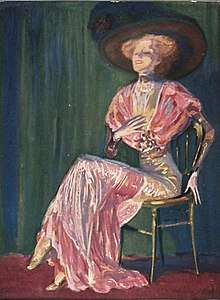Gussy Holl
Auguste Marie "Gussy" Holl (22 February 1888 – 16 July 1966)[1][2][3] was a German actress and singer. Holl was briefly a silent film star during the early Weimar Republic, appearing in productions such as F. W. Murnau's Desire (1921).[4]
Gussy Holl | |
|---|---|
.jpg) Holl in Desire, 1921 | |
| Born | 22 February 1888 Frankfurt am Main, German Empire |
| Died | 16 July 1966 (aged 78) Salzburg, Austria |
| Years active | 1913–1921 (film) |
| Spouse(s) | |
Biography
Auguste Marie Holl was born on 22 February 1888 in Frankfurt am Main. She had a brother, Georg Holl.[5]
Holl was a performer at Schall und Rauch, a cabaret in Berlin that had been founded by Max Reinhardt in 1901. Nicknamed the silver-blonde elegant witch,[6] she sang and acted. She inspired multiple songs by Walter Mehring and Kurt Tucholsky,[2] including The Blonde Lady Sings and Petronella, a parody of the Berlin trend for nudity on stage, and a dig at strip clubs. Tucholsky wrote of Holl, "Frankfurt has produced two great men: Goethe and Gussy Holl...She can do anything: hate and love, stroke and beat, sing and speak – there is no tone that is not part of her lyre."[7] and, "Unlike any other German artist, this rare and glorious woman is qualified and destined to be the great political singer. I won't even mention her tremendous art of parody and her ability to flit over the most daring things with a gracious leap – we are only interested in the artist who has more to say to a hall full of politically thinking people than ten journalists could."[8] In addition to being the number one cabaret star in the Weimar Republic,[9] she was also a successful impersonator in New York.[10]

Holl made her film debut in the 1913 short America to Europe in an Airship.[11] She did not appear in another film until 1919, when she starred in Richard Oswald's enlightenment film Prostitution alongside her husband, Conrad Veidt, and Reinhold Schünzel.[12] She next appeared in Madness (1919), followed by The Night at Goldenhall (1920), both of which were directed by and starred Veidt. Film-Kurier wrote of Holl's performance in Madness, "...Gussy Holl should give up [film] acting. It is pitiful to watch this artist – who is peerless in her own sphere – at a task which she cannot master despite her best efforts." Holl said to Lotte Eisner of the film, "The film was not only called Madness, but it was madness as well, and I can't remember anything about the story."[13]
Holl's final screen appearance was in Desire (1921).
Gussy Holl was married twice; her first marriage was to actor Conrad Veidt. Their large wedding took place on 18 June 1918.[14] The two divorced in 1922, and, one year later, Holl married Emil Jannings, who she remained with until his death in 1950. Neither marriages produced children, although Holl was stepmother to Jannings' daughter Ruth-Maria.[15] Other sources say Ruth-Maria was actually Jannings' stepdaughter, and that Conrad Veidt was her father.[16][17]
Gussy Holl died on 16 July 1966 in Salzburg.
Filmography
- America to Europe in an Airship (1913)
- Prostitution (1919)
- Madness (1919)
- The Night at Goldenhall (1920)
- People in Ecstasy (1921)
- Menschen im Rausch (1921)
- Desire (1921)
References
- Fallada, Hans (6 January 2011). "In meinem fremden Land: Gefängnistagebuch 1944". Aufbau Digital – via Google Books.
- Fallada, Hans (20 January 2015). "A Stranger in My Own Country: The 1944 Prison Diary". John Wiley & Sons – via Google Books.
- Allen, Jerry C. (1 January 1987). "Conrad Veidt: from Caligari to Casablanca". Boxwood Press – via Google Books.
- Eisner p.130
- "Bio". www.myheritage.com. Retrieved 15 April 2020.
- Gray, Jeremy (15 April 2000). "Munich". Lonely Planet – via Google Books.
- Appignanesi, Lisa (15 April 2004). "The Cabaret". Yale University Press – via Google Books.
- Finnan, Carmel (15 April 2006). "Practicing Modernity: Female Creativity in the Weimar Republic". Königshausen & Neumann – via Google Books.
- "Berlin and Potsdam". Michelin Travel. 15 January 2001 – via Google Books.
- "Cosmopolitan". Hearst Corporation. 15 April 1910 – via Google Books.
- "America to Europe in an Airship (1913) - IMDb" – via m.imdb.com.
- Smith, Jill Suzanne (15 May 2014). "Berlin Coquette: Prostitution and the New German Woman, 1890–1933". Cornell University Press – via Google Books.
- Soister, John T. (2 September 2015). "Conrad Veidt on Screen: A Comprehensive Illustrated Filmography". McFarland – via Google Books.
- Allen, Jerry C. (1 January 1987). "Conrad Veidt: from Caligari to Casablanca". Boxwood Press – via Google Books.
- Inc, Nielsen Business Media (14 January 1950). "Billboard". Nielsen Business Media, Inc. – via Google Books.
- Noack, Frank (4 March 2016). "Veit Harlan: The Life and Work of a Nazi Filmmaker". University Press of Kentucky – via Google Books.
- "Motion Picture". Macfadden-Bartell. 15 February 1928 – via Google Books.
Bibliography
- Eisner, Lotte H. F. W. Murnau. University of California Press, 1973.
External links
- Gussy Holl on IMDb